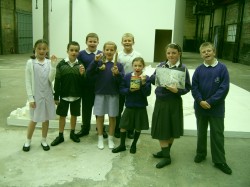Love Lane Lives
The history of sugar in Liverpool and the effects of the closure of the Tate & Lyle sugar refinery, Love Lane
The Trinity Primary School and unfinished sugar business
Written by Ron Noon at 07:11 on Thursday, July 09th 2009
It’s early morning July 9th and not long before I pick up Leon and journey off into town, then along Vauxhall Road, past the former Tates refinery site which is now the proud home of the Eldonians, left before the Green Man into Burlington Street, along to Titchfield Street and down the road into a brand new spanking Trinity Catholic Primary School. That’s where we will review the sugar and slaves project which year 5 accomplished in 2008, Liverpool’s European Capital of Culture year.
When Maggie Skilling, Leon Seth and I went into Trinity Catholic Primary school at the beginning of 08 our objective was to show our film to the parents and teachers and secure their support for a year 5 Tate & Lyle Love Lane sugar project which would also examine Liverpool’s history in the era of the slave trade. We wanted the children to become more historically aware of their SUGARLAND community just north of the city centre.
The afternoon film show proved a great success and we were able to outline our vision of what we hoped could be achieved by April and the anniversary of Love Lane’s closure. Julie McAdam and Anne Porter were the two great teachers who stimulated and supervised the children’s weekly work and who made our film visits enjoyable and productive. They were especially welcoming to the special visitors we brought along such as Albert E Sloane and Jim Smith, former Tates employees, and also young Laurence Westgaph, a local expert on Liverpool and Slavery.
This morning is a final opportunity for Leon and I to produce a “bookend” to that project by filming the children (now Year, 6), and inviting them to talk and reflect on what the project has meant to them personally and as members of a group.
Albert E Sloane and Jim Smith loved their visits to the school last year, They were questioned with a curiosity, honesty, intensity and tempo that Jeremy Paxman at his best could only dream of. The children’s questions inspired cameo responses and stories from the two wonderful “old timers” who had dedicated all their working lives to Tates. Albert’s name pops up frequently on these blogs and it was he of course who alongside his pal John McClean, who sadly passed away this year, tutored me at the start of this sugar odyssey. Jim Smith is a former driver and transport manager at Tates on the threshold of his 100th year! Unsurprisingly he first worked with teams of cart horses and then eventually the famous navy blue wagons that ferried raw sugar from the silo in the Huskisson dock to the refinery on the lane less than two miles from the river. Jim is brilliant and those who have seen our first film will hopefully before the end of this year see him and Albert again in full and loquacious flow. They were certainly in fine form in the classroom last year. (If you go back to the BLOG and the picture in the summary then you will see Jim with baseball cap on in the very back row behind the children and their lovely grandparents.)
I know there’s invariably a lag between intent and actual achievement and that there are limits to a planned script of objectives. Some of the best cameo scenes are unscripted and unplanned and that will hopefully happen again this morning. That said I am planning to ask some specific questions. First of all I want to know whether they are still dedicated SUGAR Busters! Secondly I want reassurance that they are persisting in pestering their grandparents, the former boys and girls from the whitestuff into re-telling their work and community memories. Finally, following on a lead which they had from Laurence Westgaph who they really enjoyed listening to I am going to follow up his suggestion that slavery was not just an historical topic. Laurence suggested to the children that slavery was contemporary and extended beyond what they had studied and viewed representations of down on the waterfront in the Transatlantic Slave Gallery.
The following extract tragically reinforces Laurence’s point and hopefully this morning we will get some responses from the children to a moving extract from Pedro Ruquoy.
Pedro Ruquoy, is a Catholic priest of the bateyes, (sugar plantations) in the Dominican Republic, and because he consistently spoke out against the proprietors of the sugar refineries in the Dominican Republic, he was relocated by the church in 2005 for his own safety.
He explained that:
“For more than 10 years I have had the opportunity to share the life of the cutters of sugar cane who live like slaves in the huts strewn among the fields of sugar cane. My last months in the fields were very extreme: my face appeared daily on national television where I was presented as public enemy number one of the Dominican homeland, I was the object of an unprecedented slanderous campaign and the churches where I celebrated the Eucharist were attacked. All because I made the suffering of the sugar cane workers known, making known to the world that Jesus is still dying among the gentle reed”
What is the price of sugar in 2009?
TO BE CONTINUED
